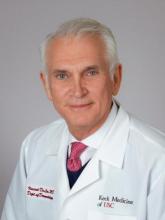More patients are being admitted to the hospital with skin problems, and specialized dermatologists are needed to provide effective treatment. Dr. Vincent DeLeo talks with Dr. Michi M. Shinohara about the evolving role of the dermatology hospitalist in the inpatient setting. Dr. Shinohara highlights some key takeaways about job satisfaction and barriers to care from a recent survey of members of the Society for Dermatology Hospitalists.
We also bring you the latest dermatology news and research:
1. Cephalosporins remain empiric therapy for skin infections in pediatric atopic dermatitis
“When a patient with AD walks into your office and looks like they have an infection of their eczema, your go-to antibiotic is going to be one that targets MSSA [methicillin‐sensitive Staphylococcus aureus].”
2. Should you market your aesthetic services to the ‘Me Me Me Generation’?
By 2020, spending by millennials will account for $1.4 trillion in U.S. retail sales.
Things you will learn in this episode:
- Inpatient care is getting increasingly complex, but dermatology has become more outpatient-centric overall: “There has really been a shift over time from dermatologists acting as the primary admitting service to more of a consulting service,” Dr. Shinohara explains. As a result, inpatient dermatology has become more specialized, leading to the development of the dermatology hospitalist.
- The Society for Dermatology Hospitalists was created in 2009 by a group of medical dermatologists to develop the highest standards of clinical care in hospitalized patients with skin disease.
- Most requests for inpatient dermatology consultations come from medical services for conditions commonly seen in an outpatient clinic. However, the hematology/oncology service is a common source of dermatology consultations, requiring a separate knowledge base.
- Dermatology hospitalists typically dedicate 25%-50% of their time on inpatient consultations.
- Time that dermatology hospitalists spend in the hospital is fundamentally different than time spent in clinic: “You have a lot more time to think about your patients and to teach about them to your trainees,” Dr. Shinohara notes. “It’s really one of the few places that I find you still have the opportunity to work as a team together.”
- Personal fulfillment is high among dermatology hospitalists, which can help combat burnout.
- A key challenge that dermatology hospitalists face is that most don’t generate the same revenue doing consultations as they do in clinic. Financial support from medical institutions and recognition of the value of the work is crucial to the longevity of dermatology hospitalists, who tend to be a younger workforce.
Hosts: Elizabeth Mechcatie, Terry Rudd, Vincent A. DeLeo, MD (Keck School of Medicine of the University of Southern California, Los Angeles)
Guest: Michi M. Shinohara, MD (University of Washington, Seattle)
Show notes by Alicia Sonners, Melissa Sears, and Elizabeth Mechcatie.
You can find more of our podcasts at http://www.mdedge.com/podcasts
Email the show: podcasts@mdedge.com
Interact with us on Twitter: @MDedgeDerm

